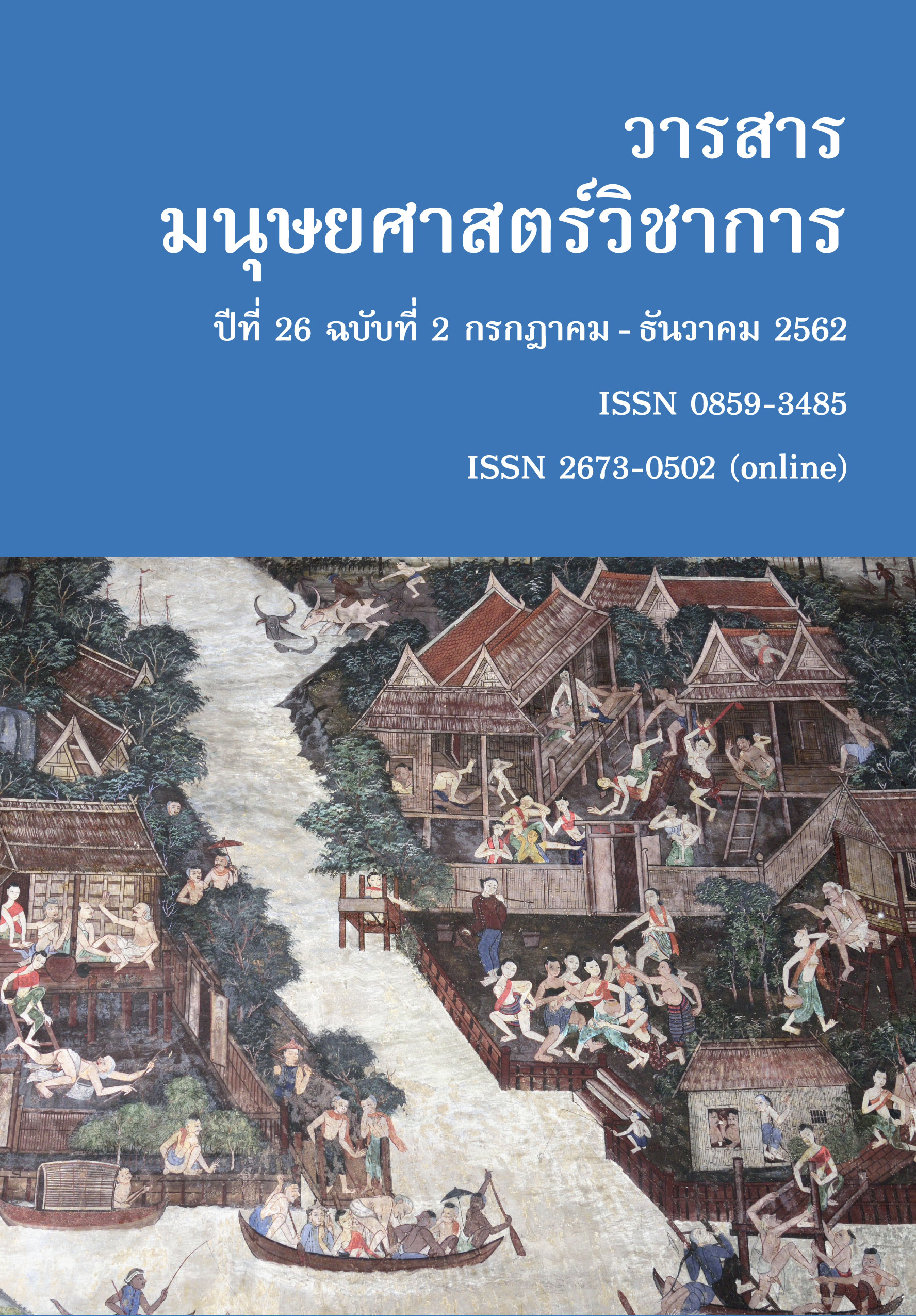Social Media and the Transformation of the Controversial Thai Child Angel Dolls
Main Article Content
บทคัดย่อ
บทความนี้ศึกษา สำรวจ และถกเถียงปรากฏการณ์ของตุ๊กตาลูกเทพในประเทศไทย ความคลั่งไคล้ ความหลงใหลที่คนไทยกลุ่มใหญ่มีต่อตุ๊กตานี้เป็นข้อถกเถียงหลักในการศึกษาปรากฏการณ์ ตุ๊กตาลูกเทพเริ่มเป็นที่รู้จักอย่างแพร่หลายในช่วง พ.ศ.2558-2560 ความนิยมนี้เกิดขึ้นจากความเชื่อในอำนาจเหนือธรรมชาติที่เหล่าตุ๊กตาลูกเทพมี อย่างไรก็ตามปรากฏการณ์แห่งความคลั่งไคล้ตุ๊กตาลูกเทพขึ้นถึงขีดสูงสุดในช่วงระยะเวลาเพียงไม่กี่เดือน ผ่านการใช้โซเชียลมีเดียของกลุ่มผู้นิยมตุ๊กตาลูกเทพ บทความนี้จึงมุ่งศึกษาประวัติการณ์ในช่วงระยะเวลาดังกล่าว พัฒนาการของปรากฏการณ์ รวมถึงวิเคราะห์ทฤษฎีและบทบาทของโซเชียลมีเดียที่สามารถแปรเปลี่ยนความคลั่งไคล้ตุ๊กตาลูกเทพของคนกลุ่มเล็กกลุ่มหนึ่งไปสู่ความเป็นตุ๊กตายอดนิยมระดับชาติได้เป็นผลสำเร็จ
Article Details
ประเภทบทความ
บทความวิจัย
เอกสารอ้างอิง
Bachor, K. (2016, June 3). Thailand’s Intriguing Luk Thep Dolls Culture. Time. Retrieved January 5, 2019 from http://time.com/4353544/thailand-luk-thep-doll/.
Chotidilok, S. and Runra, P. (2017, January 15). Goddess Dolls: The Reproduction of the Discourse “If You Don’t Believe It, Don’t Disrespect It” and the Functions of Modern Sacred Objects in Thai Society. Journal of Humanities and Social Sciences, Suratthani Rajabhat University, 9(1), pp. 149-172.
Guantlett, D. (2008). Media, Gender and Identity. Oxon: Routledge.
Head, J. (2016, February 11). Thailand’s Love of the Supernatural. BBC. Retrieved January 6, 2019 from https://www.bbc.com/news/world-asia-35529822.
Hodkinson, P. (2011). Media, Culture and Society: An Introduction. London: Sage.
Kunhalung, R. (2014). Communication about Kumanthong Sacredness in Thai Society. (Ph.D. in Communication Arts). Chulalongkorn University, Bangkok.
Parinyaporn, S. (2016). Superstitions Regarding Animals: Mutation and Reincarnation in a Thai Context. GAI International Academic Conferences Proceedings. (pp. 24-27). Amsterdam; Global Academic Institue.
Post Reporters. (2016, January 27). CAAT Curbs ‘Angel Child’ Tickets. Bangkok Post. Retrieved December 20, 2018 from https://www.bangkokpost.com/news/security/840432/caat-curbs-angel-child-tickets.
Tanakasempipat, P. and Kittisilpa, J. (2016, January 27). Thais Turn to ‘Child Angel’ Dolls as Economy Struggles. Reuters. Retrieved December 10, 2018 from https://www.reuters.com/article/us-thailand-dolls/thais-turn-to-child-angel-dolls-as-economy-struggles-idUSKCNOV5011.
Walker, R. (2005, February 20). The Way We Live Now: Consumed: Hyperreality Hobbying. New York Times Company. Retrieved December 17, 2018 from https://www.nytimes.com/2005/02/20/magazine/hyperreality-hobying.html.
Wong, K. (2004). Nang Nak, the Cult and the Myth of a Popular Ghost in Thailand, in Siraporn Nathalang (ed.) Thai Folklore: Insights into Thai Culture, Bangkok: Chulalongkorn University Press.
XP Staff. (2016, January 28). Is This the Doll of Destiny? The Nation. Retrieved December 15, 2018 from http://www.nationmultimedia.co/life/Is-this-the-Doll-of-destiny-30277898-html.
Zajc, M. (2015, March 1). Social Media, Prosumption, and Dispositives:
New Mechanism of the Construction of Subjectivity. Journal of Consumer Culture. Retrieved August 12, 2019 from https://doi.org/10.1177/1469540513493201.
Chotidilok, S. and Runra, P. (2017, January 15). Goddess Dolls: The Reproduction of the Discourse “If You Don’t Believe It, Don’t Disrespect It” and the Functions of Modern Sacred Objects in Thai Society. Journal of Humanities and Social Sciences, Suratthani Rajabhat University, 9(1), pp. 149-172.
Guantlett, D. (2008). Media, Gender and Identity. Oxon: Routledge.
Head, J. (2016, February 11). Thailand’s Love of the Supernatural. BBC. Retrieved January 6, 2019 from https://www.bbc.com/news/world-asia-35529822.
Hodkinson, P. (2011). Media, Culture and Society: An Introduction. London: Sage.
Kunhalung, R. (2014). Communication about Kumanthong Sacredness in Thai Society. (Ph.D. in Communication Arts). Chulalongkorn University, Bangkok.
Parinyaporn, S. (2016). Superstitions Regarding Animals: Mutation and Reincarnation in a Thai Context. GAI International Academic Conferences Proceedings. (pp. 24-27). Amsterdam; Global Academic Institue.
Post Reporters. (2016, January 27). CAAT Curbs ‘Angel Child’ Tickets. Bangkok Post. Retrieved December 20, 2018 from https://www.bangkokpost.com/news/security/840432/caat-curbs-angel-child-tickets.
Tanakasempipat, P. and Kittisilpa, J. (2016, January 27). Thais Turn to ‘Child Angel’ Dolls as Economy Struggles. Reuters. Retrieved December 10, 2018 from https://www.reuters.com/article/us-thailand-dolls/thais-turn-to-child-angel-dolls-as-economy-struggles-idUSKCNOV5011.
Walker, R. (2005, February 20). The Way We Live Now: Consumed: Hyperreality Hobbying. New York Times Company. Retrieved December 17, 2018 from https://www.nytimes.com/2005/02/20/magazine/hyperreality-hobying.html.
Wong, K. (2004). Nang Nak, the Cult and the Myth of a Popular Ghost in Thailand, in Siraporn Nathalang (ed.) Thai Folklore: Insights into Thai Culture, Bangkok: Chulalongkorn University Press.
XP Staff. (2016, January 28). Is This the Doll of Destiny? The Nation. Retrieved December 15, 2018 from http://www.nationmultimedia.co/life/Is-this-the-Doll-of-destiny-30277898-html.
Zajc, M. (2015, March 1). Social Media, Prosumption, and Dispositives:
New Mechanism of the Construction of Subjectivity. Journal of Consumer Culture. Retrieved August 12, 2019 from https://doi.org/10.1177/1469540513493201.


